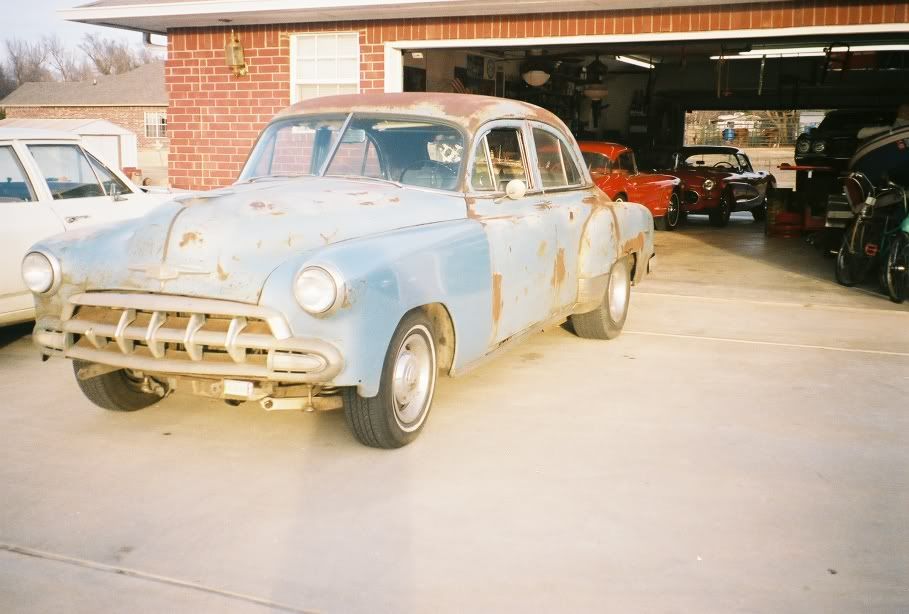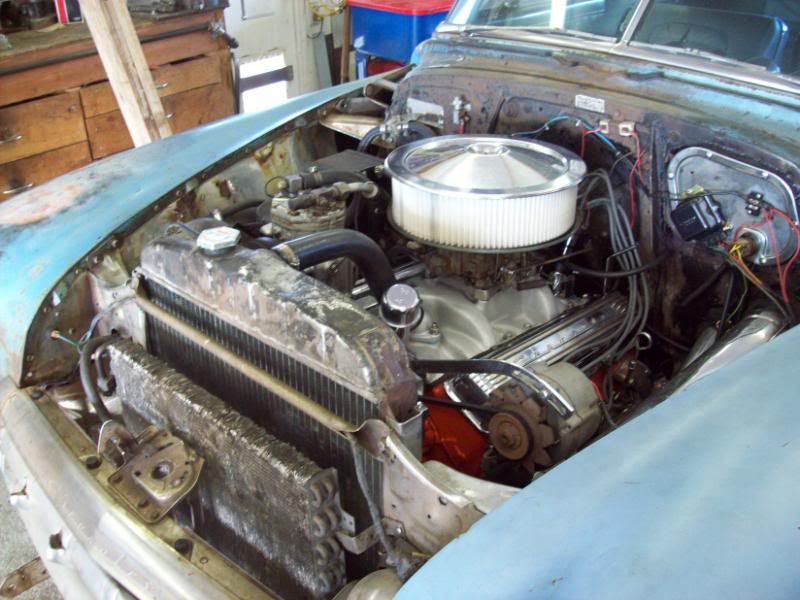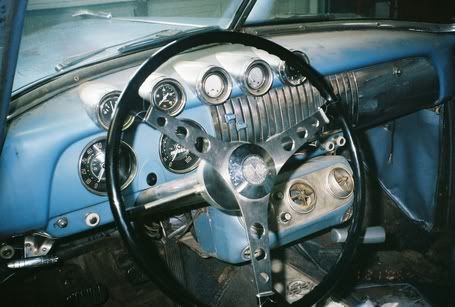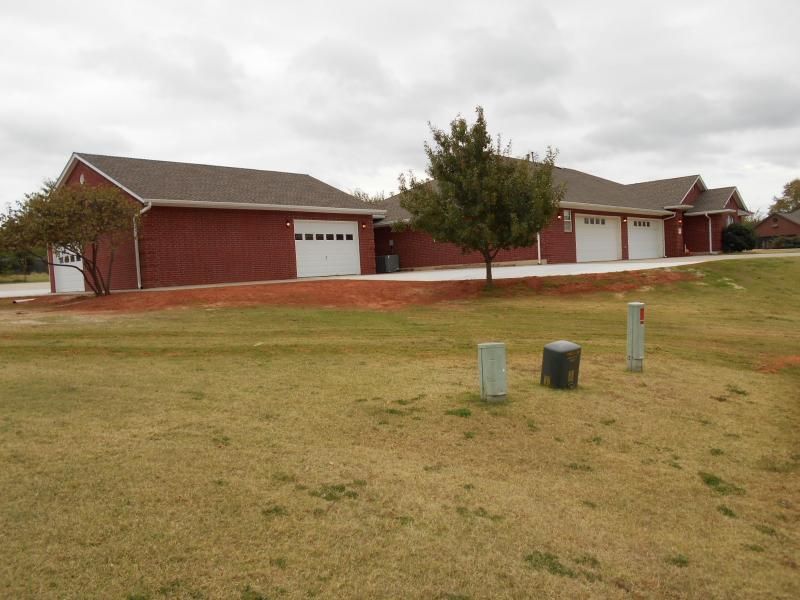327 small journal questions
#41
Drifting


If anybody is building a small block for PERFORMANCE and doesn't build a 383 [or variation] is making a mistake. Either modify a large journal crank to fit the 327 OR line bore the block for a large journal crank. Few years back somebody made a small journal 383 crank, still may...a 383 will get your power at a lower RPM. It will have seat of the pants power superior [far] to a 302/327/350.
#42
Race Director


Member Since: Apr 2015
Location: Fresno California
Posts: 17,505
Received 3,443 Likes
on
2,113 Posts
My '61 has a 383 built off of a '67 block that has been run hard and put away wet. It was built 25 years or more ago, and has some blowby. After I got the car and repaired the blown head gasket and water pump, and installed the original intake, I could not believe how strong that engine pulled. And still does. It looks exactly like a 283, with the closed valve covers, etc,. but you can start out in third gear without it bogging. Mountains of torque. And good throttle response everywhere from idle on up. As a guy who's used to big-block style torque in his GTO's, the little 383 was a big surprise.
#43
Safety Car


Member Since: Sep 2004
Location: St. Clair Shores MI
Posts: 4,050
Received 132 Likes
on
74 Posts
C2 of Year Finalist (track prepared) 2019
2017 C2 of the Year Finalist

If anybody is building a small block for PERFORMANCE and doesn't build a 383 [or variation] is making a mistake. Either modify a large journal crank to fit the 327 OR line bore the block for a large journal crank. Few years back somebody made a small journal 383 crank, still may...a 383 will get your power at a lower RPM. It will have seat of the pants power superior [far] to a 302/327/350.
wow, that sounded wrong.
#44
Race Director



Member Since: Mar 2001
Location: Mustang OK
Posts: 13,852
Received 3,772 Likes
on
1,674 Posts
2023 C1 of the Year Finalist - Modified
2015 C1 of the Year Finalist

And I fully agree with building a 383. We all know, cubes is the trick. My rusty POS 51 Chevy (with air cond and 2 heaters, no radio) with a healthy built 383 (actually, it's 388 because it required a .060 bore) fools 'um all the time. The rear is a 3.08 in a 57 axle housing and with the M20 Muncie, it all works just fine------------stop light or Interstate.






Last edited by DZAUTO; 12-06-2016 at 03:27 PM.
#46
Race Director



Member Since: Mar 2001
Location: Mustang OK
Posts: 13,852
Received 3,772 Likes
on
1,674 Posts
2023 C1 of the Year Finalist - Modified
2015 C1 of the Year Finalist

One heater is the basic version which came in early (49-54) Chevys. The other heater is an under seat heater from a 55 Buick that I pulled out of a salvage yard back in the mid-60s. I don't know which years or models of GM cars had these type of heaters under the front seat (Buick, Olds, Cad???). The circular heater core was under the driver side of the front seat with a 3 blade fan in the center of the core. There was a duct around the core which went across under the front seat and directed air to the rear seat area. Since I have bucket seats and console in the 51 (from a 63 Impala SS), I cut off the portion of the duct which went across to the passenger side. Thus, there is only the core, fan and duct under the driver bucket seat. Both heaters work good, but they are needed because of all the holes and worn out weather strip on the 51 which allows lots of cold air into the car when going down the road.
Same situation with the air cond. It blows super cold on R12, but only the front seat area gets cool because of all the hot air coming in when driving in the summer. Until I retired, this was literally my daily driver and was a landmark where I worked (Tinker AFB in Okla City).
Same situation with the air cond. It blows super cold on R12, but only the front seat area gets cool because of all the hot air coming in when driving in the summer. Until I retired, this was literally my daily driver and was a landmark where I worked (Tinker AFB in Okla City).
Last edited by DZAUTO; 12-06-2016 at 11:23 PM.
#50
Le Mans Master


Member Since: Oct 2002
Location: Las Vegas - Just stop perpetuating myths please.
Posts: 7,098
Received 373 Likes
on
356 Posts

Damn you, just as I thought I had my mind made up  You go and make a really good point.
You go and make a really good point.
Were the 375 HP rotating assemblies the same? Pistons, rods, etc.? I know the only difference between the 210 and 275 HP 327's in the 1967's were the heads, intake and carb. So a set of AL heads, intake and headers and you're already well over 300 HP. Roller cam conversion and you should be close to 400 HP with good street manners.
But - someone said the rods were the weak point. So are we still pulling the engine? Are the rods the same as the 375 HP? Anyone know?
 You go and make a really good point.
You go and make a really good point.Were the 375 HP rotating assemblies the same? Pistons, rods, etc.? I know the only difference between the 210 and 275 HP 327's in the 1967's were the heads, intake and carb. So a set of AL heads, intake and headers and you're already well over 300 HP. Roller cam conversion and you should be close to 400 HP with good street manners.
But - someone said the rods were the weak point. So are we still pulling the engine? Are the rods the same as the 375 HP? Anyone know?
So how fast were you going there?
I've made my final decision. I'm going to massage the 327, not go overboard to get in the area of 375 HP. I will NOT beat it to death.
If / when I get tired of that (remember I'm coming from a 650 HP Z06), then I'll go the nuclear option and bag and tag the motor. I'll put in a 400+ ci SBC and run the pizz outta it.
PS - the 355 I built for my first 67 Camaro was built directly from a Super Chevy article in the 1980's using a Comp Cams 268H cam and 186X double hump heads. (when did these kids start calling double hump heads camel hump heads?????) That engine would run high 11's / Low 12's and was a VERY reliable street motor, economical, reliable, etc. And that was with 2.73 gears!
I was consistently ranked in the top 5 for Div 3 NHRA and printed in the National Dragster magazine every week. Tons O Fun.
I've made my final decision. I'm going to massage the 327, not go overboard to get in the area of 375 HP. I will NOT beat it to death.
If / when I get tired of that (remember I'm coming from a 650 HP Z06), then I'll go the nuclear option and bag and tag the motor. I'll put in a 400+ ci SBC and run the pizz outta it.
PS - the 355 I built for my first 67 Camaro was built directly from a Super Chevy article in the 1980's using a Comp Cams 268H cam and 186X double hump heads. (when did these kids start calling double hump heads camel hump heads?????) That engine would run high 11's / Low 12's and was a VERY reliable street motor, economical, reliable, etc. And that was with 2.73 gears!
I was consistently ranked in the top 5 for Div 3 NHRA and printed in the National Dragster magazine every week. Tons O Fun.
Well the only experience i have with a small journal 327 was in my first car a '62 impala w/3sp. I really didn't know much when i put lousy heads on a short block w/domed pistons. Compression ratio? What the heck is that?? Anyways i wooped the heck out of it and broke rear ends on a regular basis. I recall replacing a "pumpkin" along side the interstate to get the car home. Found a hole in the housing tin cover where a gear tooth flew to freedom. But the 327 never quit, it never quit. Burned up a lot of rubber but the 327 always drove away. But thats my only experince so take it or leave it. Well that and did meet a '68 corvette owner that claimed his 327 car ran 12's. And i have seen a 10sec 327 Nova at the drags though it got there on a trailer it did look fairly stock.
I dont have the time it takes to dig up all the rotating assembly parts info for the 327. I can tell you if you tap on the crank and it rings its a forged crank and if it make a dull thud its a cast crank. But even the cast cranks are strong parts as long as you keep RPM <6000RPM. I say focus more on a short duration cam with a tight LSA than looking for high RPM hp.
Now as for rods the procedure for preparation for performance has been around for as long as they have raced the sbc. It takes more effort than $$$ but if your interested in how i'd do them when your ready just post the question. I say this because i know at least SCAT sells small journal sbc rods at resonable prices and should outlive any street build. Preping stock rods gonna just start w/inspection/magnifluxing, then polish the beams and smooth the bolt head pockets, shot peening and installing new high strength bolts of course. Finally the reconditioning of the big end.
Not much to argue about really. If you want a powerful 400ci motor then go for it. If you want a perky 327 that has the cars original numbers you can do that for less money with the parts you already have. Just get the machine shop that decks your block to ensure they dont grind off the stamped numbers. Maybe even better to just run a thin steel shim head gasket for your iron heads and not even deck the block. Felpro has a thin 0.015" compressed height gasket that works great - have on my corvette now and it sealed up tight even after 1 overheat/boil over.
Sorry for the late reply. Well i like your decision and hope we can help you make it happen.

#51
Le Mans Master


Crankshaft note: if you tap it and it rings like a bell it is a good crank. Forged or cast iron will ring if good.
If you tap it and get a dull thud you have a crank with cracks in it forged or cast iron.
That is what Federal Mogul taught me.��
If you tap it and get a dull thud you have a crank with cracks in it forged or cast iron.
That is what Federal Mogul taught me.��
#52
Race Director


Member Since: May 2000
Location: Redondo Beach USA
Posts: 12,487
Received 1,974 Likes
on
1,188 Posts

That's how railroad maintenance men traditionally checked for cracked wheels, but I expect they have better methods, today.
Given the much more complex geometry of crankshafts, the "ring test" will only reveal large cranks. Most cracks start from microscopic surface flaws and grow over time due to cyclic loading.
The best way to identify these small flaws and young, small cracks is Magnaflux inspection of the crankshaft. Magnaflux inspection should be done to all used cranks and maybe even new ones if they are not Magnaflux inspected in production. Ask the manufacturer. It's best to Mag the raw forgings/castings, then again after final machining.
The most critical areas are the intersections of the cranks cheeks and journals, and generous fillet radii at these locations go a long way in preventing cranks that can lead to fatigue failure.
Duke
Given the much more complex geometry of crankshafts, the "ring test" will only reveal large cranks. Most cracks start from microscopic surface flaws and grow over time due to cyclic loading.
The best way to identify these small flaws and young, small cracks is Magnaflux inspection of the crankshaft. Magnaflux inspection should be done to all used cranks and maybe even new ones if they are not Magnaflux inspected in production. Ask the manufacturer. It's best to Mag the raw forgings/castings, then again after final machining.
The most critical areas are the intersections of the cranks cheeks and journals, and generous fillet radii at these locations go a long way in preventing cranks that can lead to fatigue failure.
Duke
#53
Melting Slicks


And I fully agree with building a 383. We all know, cubes is the trick. My rusty POS 51 Chevy (with air cond and 2 heaters, no radio) with a healthy built 383 (actually, it's 388 because it required a .060 bore) fools 'um all the time. The rear is a 3.08 in a 57 axle housing and with the M20 Muncie, it all works just fine------------stop light or Interstate.






I have a 1955 Chevy Belair I like to do something with it....What you did to your 51...
love it

#54
Drifting


And I fully agree with building a 383. We all know, cubes is the trick. My rusty POS 51 Chevy (with air cond and 2 heaters, no radio) with a healthy built 383 (actually, it's 388 because it required a .060 bore) fools 'um all the time. The rear is a 3.08 in a 57 axle housing and with the M20 Muncie, it all works just fine------------stop light or Interstate.






#55
Race Director



Member Since: Mar 2001
Location: Mustang OK
Posts: 13,852
Received 3,772 Likes
on
1,674 Posts
2023 C1 of the Year Finalist - Modified
2015 C1 of the Year Finalist

#56
Drifting


EDIT - I know It's not going to be easy with stock heads, I'm either looking at AL heads painted orange, or there's a guy out there that machines Dart heads to LOOK like double hump heads. I'm NOT - NOT trying to fool any judges here, just the general public at car shows and such, I want it to LOOK stock to the average Joe.
My new-to-me 67 Camaro has a 327 small journal, original, numbers matching engine. It has only 210 HP which I can't stand Especially after owning my Z06 at over 600 HP.
Especially after owning my Z06 at over 600 HP.
I want to retain the stock look of the car, (except the color, butternut yellow). I also love 327's. The car is in far too good condition to modify much at all.
I want to substantially up the HP of the engine without getting too radical of course. Since the engine is the born-with car I don't want to risk ruining the block. Of course it's always an option to mothball this engine and store it, putting a temporary 400 sbc or other sbc in it.
So - 2 questions:
1. What can the stock bottom end of a small journal 327 handle, RPM and HP wise?
2. If I upgrade the rods, pistons, main bolts and rod bolts (I don't see any reason to change the crank, am I wrong?) what can the short block handle, both RPM and HP wise?
I understand it's pretty stout for a 2 bolt main with a forged crank and all, what are the weak spots? (OK that's three questions)
My goal would be to get reasonably close to 350 to 400 HP at the FLYWHEEL (not rear wheels). So yeah, I'm talking good heads and a roller cam, but everything painted orange of course LOL...
Thank you.
My new-to-me 67 Camaro has a 327 small journal, original, numbers matching engine. It has only 210 HP which I can't stand
 Especially after owning my Z06 at over 600 HP.
Especially after owning my Z06 at over 600 HP.I want to retain the stock look of the car, (except the color, butternut yellow). I also love 327's. The car is in far too good condition to modify much at all.
I want to substantially up the HP of the engine without getting too radical of course. Since the engine is the born-with car I don't want to risk ruining the block. Of course it's always an option to mothball this engine and store it, putting a temporary 400 sbc or other sbc in it.
So - 2 questions:
1. What can the stock bottom end of a small journal 327 handle, RPM and HP wise?
2. If I upgrade the rods, pistons, main bolts and rod bolts (I don't see any reason to change the crank, am I wrong?) what can the short block handle, both RPM and HP wise?
I understand it's pretty stout for a 2 bolt main with a forged crank and all, what are the weak spots? (OK that's three questions)
My goal would be to get reasonably close to 350 to 400 HP at the FLYWHEEL (not rear wheels). So yeah, I'm talking good heads and a roller cam, but everything painted orange of course LOL...
Thank you.
Regarding your question about heads, Randy Brzezinski at Brzezinski Racing can machine a Dart iron head to look like an OEM '461/462/291 double-hump head. Attached is a photo of a Dart 200 cc iron head (on the right) machined to look like an OEM double-hump head (on the left). The Dart head flows 257 CFM at 0.500" lift.
Recently I read that Trick Flow has introduced an aluminum head that looks like the vintage double-hump head.
Note that the 1967 '657 block casting was used by GM for both small-journal 327 engines and large-journal 350 engines. So, you could convert a '657 small-journal block to a large-journal block if you want to.
I agree with DZAUTO that "there's no replacement for displacement." I wrote an article in the NCRS Restorer magazine in 2015 about converting an original 1967 327 '657 block to a large-journal, 4-bolt main, roller cam 383. With the Dart heads this engine made 424 HP with open headers.
In summary, I think that a 383 with the stock '657 block is a almost a no-brainer. If you want more, a Dart Sportsman block with 4.125" bores will get you to 427 CID. This can be done while maintaining the general appearance of a stock 1967 L79 350 HP engine.
#57
Le Mans Master


The thud test on a crank still holds true, Cast or Forged. If it thuds find a new crank. Good points on magna flux test.
Racers for years used the large filets to help avoid crank failures, performance bearings are actually narrow or chamfered compared to stock bearings to allow space for these large fillets or radius on cranks.
Racers for years used the large filets to help avoid crank failures, performance bearings are actually narrow or chamfered compared to stock bearings to allow space for these large fillets or radius on cranks.








